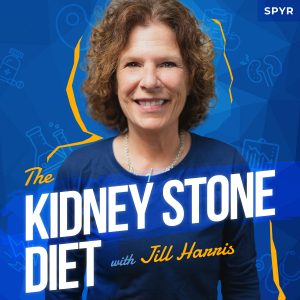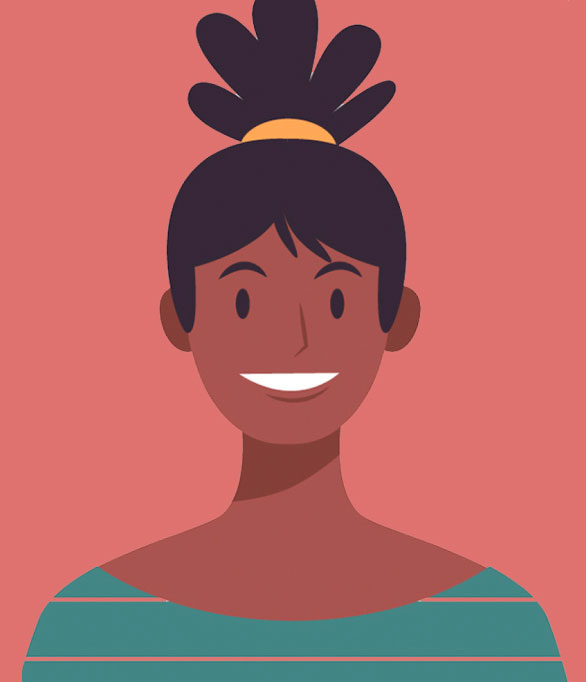This week, Jill talks about tea and whether it’s safe to drink as a kidney stone former.
Jeff Sarris: Welcome back to the Kidney Stone Diet podcast, the show about reducing your kidney stone risk and living your best life. I’m your host and fellow student, Jeff Sarris.
Jill Harris: And I’m Jill Harris, your kidney stone prevention nurse. I’m so happy to be here. I’m still writing a high because we just celebrated our 100th episode.
Jeff Sarris: Yeah, a few weeks ago for the listeners, but it’s all on the same day because this is how it makes the most sense for us to record. So, it works really well this way for us.
Jill Harris: Yes, and we’re still with each other and that’s great.
Jeff Sarris: Yeah, we get to hang out a little longer, too, which is fun. And it does feel like we need to do this. We need to try to work this in somehow because busy schedules. It is hard. It’s a full day of travel for you to get here or us to get by you and just everything together, but it’s fun.
Jill Harris: You have it set up so nicely, I would definitely travel here. And, you know, we should do this more just because I think it’s so wonderful to have your presence with mine. I just enjoy it. I don’t even care what the listeners think. I’m enjoying it. No, but people would say, “Oh, it sure would be nice if you guys could be in the same room.” And it is, so you guys were right. It is very nice to be in the same room.
Jeff Sarris: Oh, definitely. And I feel like we’ll need to get Amara a mic, too, over there. She’s off-camera, off-mic doing it.
Jill Harris: Well, she just came up with the title for this episode, so, yes, we do need to mic her, for sure.
Jeff Sarris: Which, actually, what is that? Does tea cause kidney stone? So, last episode, we talked about dark drinks and things, but we actually didn’t touch on tea and tea is a big one. As soon as we finished, you were like, “That’s something we need to stick a pin in and talk about.”
Jill Harris: Yes, you know, tea should have been one of the first ones we did, but there’s so much to talk about. And this is why when people come to us and they’re like, “It’s so overwhelming.” They’ve just been sick, they’ve just had a surgery, they’re just recovering, and now they have to figure out all of this information on how to prevent kidney stones. That’s not easy. Kidneystonediet.com, the Start page, we have made a page where all the resources–where that page is really like, “Holy bragioli, I need help. I’m overwhelmed! Where do I start?” Kidneystonediet.com “Start page.” You’ll find great starting materials, so you can get a little grounded and go, “Okay, so now I feel a little bit better.” When you feel a little bit better emotionally, you can start your journey to prevention.
How Much Tea Is Too Much?
And so, tea. So, last week, Jenny called and her doctor threw her a brochure that said stay away from dark liquid, basically. I didn’t bring up tea in that episode. We focused on soda because, like Jenny, we didn’t know what the hell the doctor meant. So, Amara over here said, well, you know something about tea and I’m like, “Oh, shoot. That could have been in the dark liquid he meant.” But, again, we don’t know. Anyway, tea. Tea is high in oxalate. “Okay, Jill, but there’s 5000 teas.” Here’s the deal, people. You can absolutely have tea on the Kidney Stone Diet. There’s not a problem with that. The patients who formed kidney stones because of tea, or so they tell me, is because they were drinking tea all day long, 10 cups, 11 cups, 12 cups, with absolutely no calcium in their diet. And so they had high oxalate levels.
So, the next question is, we know black tea is high in oxalate, we know that, but there’s “sleepy bear” tea, “My grandma went to take a nap” tea, “flowers and sunshine” tea, and you name it. There’s all kinds of teas out there. There’s not a day that goes by that people say, “Jill, I’m drinking wildflower tea. What’s the oxalate in that?” And I’m like, “Look, Pam, I don’t know what the oxalate is in wildflower tea.” But I know this: when we eat and drink everything appropriately, not all day long, not all day long, then, we don’t have a problem with oxalate. And, more importantly, we get our calcium needs met every day because if you are taking in a lot of oxalate, and you’re not taking in any calcium, oxalate gets reabsorbed back into your body. When you’re taking in the appropriate amount of calcium and you can go to kidneystonediet.com, my blog, to find out what that is for you, then oxalate and calcium bind together in your gut and leave to the stool so you don’t have an over absorption problem with oxalate.
So, as we take away spinach and almonds because they’re pretty high in oxalate, and we eat everything else, once or twice a week in a normal portion size, nobody makes kidney stones if they had an oxalate problem, and they take that advice. Now, that advice is not easy if you love chocolate, and peanut butter, and rhubarb, and all those other really high oxalate things, but portion not perfection. You can still have peanut butter on the Kidney Stone Diet. We have a YouTube video to show you that. You can have chocolate, but you’ve got to know yourself. Like I can’t eat Cheeze-Its because I will eat the whole box. Even me will eat the whole box so they are not in my house. So if you love peanut butter, and you’re triggered by it, and if you get the spoon and you eat the whole jar, you’re gonna have an oxalate problem, especially if you’re not getting any calcium because it’s super high in oxalate.
So it’s always about portion. You can have tea, one cup or two cups a day. A true cup, not Starbucks “I’m feeding a family of five cup.”
Jeff Sarris: What about this?
Jill Harris: No, it’s too big! A cup! The only thing in there should be exactly what you’re doing: water. That’s beautiful. I love to see it. But a true eight ounce or less cup. So one or two a day. So people in England, it’s a cultural thing. They’re drinking tea all day long. I have a lot of patients from England, by the way. Or people in Georgia, like Jenny was in our last episode and, like I said, her doctor could have been saying tea, but he just said dark Cola, dark sodam or dark whatever!
So, maybe she was drinking too much sweet tea in Georgia. So some of the things that we love are a cultural thing. It’s what people were we live do, right? We Italians were eating pasta on Sundays or whatever, one day a week we’re doing that. So it’s just how you–Italian cookies, we’re doing that. So there’s just certain things that our culture has taught us that we just love and they’re familiar to us and we just enjoy it. So drinking sweet tea all day long, drinking black tea all day long, stop doing things all day long. That’s what got you into trouble with oxalate along with not getting your calcium.
All the other teas, I know New England Journal of Medicine study green tea–one brand–and they said it’s low, so everyone thinks all green teas are low. We have that study. And, in general, green teas are low, but we will never have a problem with tea and oxalate if we have one or two cups a day. So don’t worry about the type of tea you’re drinking. Just worry about the portion size in which you’re drinking it and getting your calcium needs met every day, and you can still have tea in your cup if you’d like.
Jeff Sarris: So I then have a question. Now, there are all the herbal teas like you mentioned, that have all these different names and things and it’s like “sleepy bear, blah, blah, blah.” Would would you say there’s any difference if it actually has almond in it?
Jill Harris: No, because it’s usually like an extract or an oil that they’ve just flavored it with. That doesn’t count. The other thing I want to say, too, the longer you steep a tea, the more oxalate it will have. Some people will leave that teabag in there all day long, right? And then they’ll just you know sip it all day long. Well, that will have more oxalate for sure. But, again, it’s a portion problem with everything in our life. We’re never going to get obese if we watch our portion sizes. Many times we will be able to curtail chronic disease if we just eat all things within portion size. Eat responsibly, and you won’t have any issues. Also, getting your calcium needs met everyday to get rid of the excess oxalate. Very important. So tea, absolutely have it if you can enjoy it responsibly.
Jeff Sarris: Yeah, I think that’s perfect. And it is so important because knowing that it’s high, knowing that it’s something that could be an aggressive oxalate suck out of your credit card for the day–
Jill Harris: Yeah, your bank account.
Jeff Sarris: That’s good to know.
But What About “This” Type of Tea?
Jill Harris: And I think there was–oh, and so you don’t have to ask me every tea in the world because there’s hundreds of teas, right. And I understand why patients get so confused. They’re like, “Okay, but I drink this tea. What do you think?” I don’t know. It has not been studied. It won’t be studied. It’s expensive to study. It’s hard to study oxalate. It differs from plant to plant because it’s in plant foods, depending on the soil and the growing conditions. So, this advice I give may seem generic to some–”Well, she says just have a little portion. It’s no big deal, even though Harvard says it’s high.” But the reason I’m able to give you, sometimes, what seems like generic advice to you is because I’m looking at thousands of urine collections, people’s follow-ups, and when they originally came to me there oxalate was 60 and now it’s 20 because they took the advice and they did something with it.
So I know it works, unless you have malabsorption issues. It’s not like I’m just being glib and not thinking about each and every one of you. I know that this works because I look at the follow-up urine collections and I see after people talk to me and they work and get and put everything into a plan, then their oxalate will be–it will never be something they have to worry about because they learned it. It’s the salt and sugar people should be freaking out about, and the water, and the calcium, all the other things, but once you get the oxalate part of this, which takes just a couple of videos, you’ll see it’s it really is the least important thing. But everyone wants to focus on it. Jeff’s like, “Is she still talking?” Sarah just looked at Bob and said, “Bob, get up. She’s still talking.” But this is an important thing for people, because this is the thing I’m asked about the most. Once you get that advice, you won’t have an oxalate problem anymore.
Focus on the other parts of the Kidney Stone Diet because they’re so very important. But malabsorption people that advice does not go to you because you have special issues and I always want to acknowledge you and say I see you that’s a whole different ballgame. So, for the average stone former that was eating too much spinach and almond, slow your roll, people, on eating the same damn things all the time in any amount you want because you’re heard it was healthy. And have your tea, but within portion. The end.
Jeff Sarris: I think that is a perfect wrap-up of everything. And I know that was an FAQ, but if you have any questions out there, whether tea or anything else, the number is 773-789-8763. I know we covered tea, but you know what I mean. Like if you have anything related or if it brings up another question that talking about these different teas and understanding that you can’t have it, but if something else comes up, let us know and we will feature you in a future episode.
Jill Harris: Well, guess what? I have one more thing. The reason people–people are like, “How the hell are you talking about this oxalate everyday for all these decades?” Because if you went into your doctor’s office, and the only thing they said was the word “oxalate” and, guess what, you don’t even know what that is? Well, that is what you’re going to attach to. Most doctors, they’re not talking about salt and sugar. Salt, yes, sugar, not so much. So there’s this whole diet that we have to help lower stone risk, but everybody, including healthcare professionals, want to focus on the oxalate part, okay? It’s really the smallest bit of this, unless you have malabsorption issues. The other things are the holy bragioli moment that you’re going to have to learn.
Jeff Sarris: But that’s a good point because oxalate almost feels like that magic pill, of sorts, because it’s something I’ve never heard of. This is the one thing that will solve everything.
Jill Harris: And they made a calcium oxalate stone! So they’re like, “Oh, my God! What is this oxalate thing? We’ve got to research this!” And, once they get a hold of me, they’re like, “She said it ain’t that big of a deal, but I made a calcium oxalate stone the doctor talked about oxalate.” Once you understand what you don’t know, it’s really the super simplest part. I’d rather you worry about all the other parts, mostly. I promise, I promise, and I don’t make promises glibly. I promise that’s the truth.
Jeff Sarris: Yeah, for sure. So if you have any questions about the Kidney Stone Diet, about the different goals and everything, you can go to kidneystonediet.com. There’s the Prevention Course, there all the free resources, the blog posts, that it breaks everything down, the newsletter, the meal plans. I haven’t brought up the meal plans in a little bit! That is a daily inspiration for breakfast, lunch, dinner, and a snack every single day of the week, where it can help keep you on track. Not to tell you what you should eat, but to show what you can eat. It’s a big difference.
Jill Harris: And that’s a very popular service because people are always every day they’re like, “Oh my God, I don’t know what I can eat on this diet.” So much, baby, so much that we have a meal plan to show you! It’s very cheap at $19 a month.
Jeff Sarris: Absolutely!
Jill Harris: Cancel anytime.
Jeff Sarris: Yeah, for sure. There’s so many recipes in there. So many things you’re constantly creating. I love seeing all the new photos because it’s just amazing. And who knows what we’ll do in the future with more recipes.
Jill Harris: We got things in our basket.
Jeff Sarris: But yeah, thanks again for tuning in, everyone, and we will see you next time.
Jill Harris: Bye, guys!














Leave a Reply